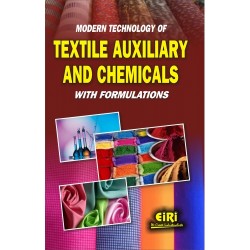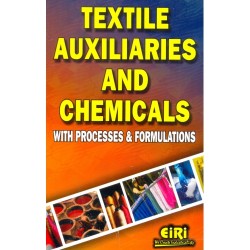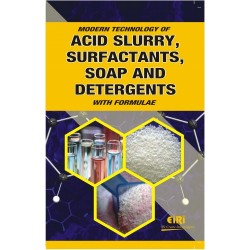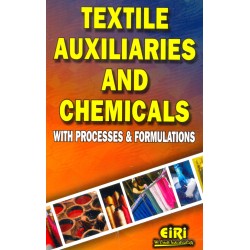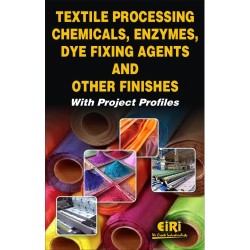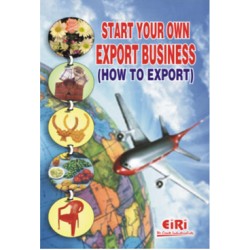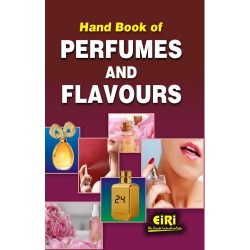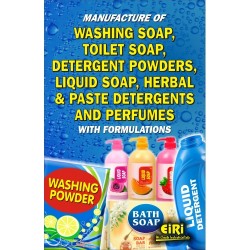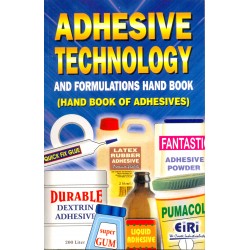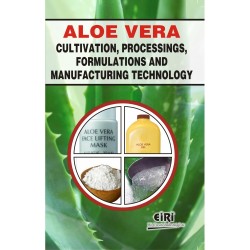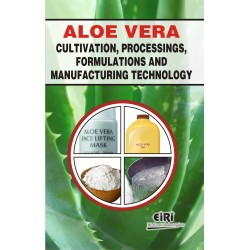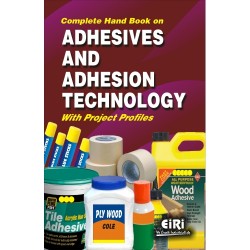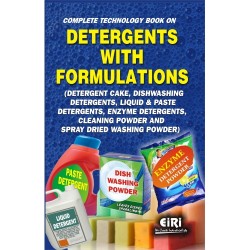Technology of Textile Chemicals with Formulations (hand book)
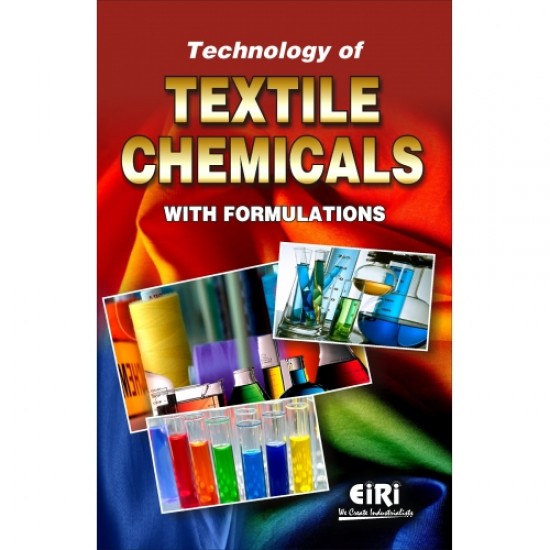
- More than 40 years of experience
- Managed by expert industrial consultants
- ISO 9001-2015 Certified
- Registered under MSME, UAM No: DL01E0012000
- 24/5 Research Support
Get your quesries resolved from an industry expert. Ask your queries before report or book purchase. - Custom Research Service
Speak to the our consultant to design an exclusive study to serve your research needs. - Quality Assurance
All reports are prepared by highly qualified consultants & verified by a panel of experts. - Information Security
Your personal & confidential information is safe & secure.
The book covers Technology of Fabric Manufacture, Agents for Textile Printing Binders, Scouring, Surfactants, Surface Active Compounds as Basic Components, Thickening Agent for Textile Material, Thickening Agent Based on Tamarind Seed Gum, Aloe Vera Gel based Thickening Agent, Bleaching, Bleaching of Wool, Laccases for Denim Bleaching, Cationic Fixing Agents, Treatment of Textile Wastewater, Optical brighteners, Plant Fibres for Textiles Extraction of Plant Dyes, Dyeing with Disperse Dyes, Wool Dyeing and Silk Fibres, Morphology of Wool, Conductive Polyelectrolytes, Fibres Conductance Analysis, Dependence of Conformational State of Polyelectrolyte on pH, Plant Economics of Detergent Paste (Textile Grade), Plant Economics of Dispersant for Textiles, List of Formulations of Printing Ink, Properties and Application of the Formulations, Anti Crease Formulations Auxiliary for Textile Wet Finishing Formulation, Ant Microbial and Anti Crease Formulation, Crease and wrinkle proofing cellulosic textile formulation, Formulation for Diquaternary Ammonium Salts as Textile Finishing Agents, Garments Dyeing Process and Fabric Dyeing Process Formulations.
TECHNOLOGY OF TEXTILE CHEMICALS WITH FORMULATION
TECHNOLOGY OF FABRIC MANUFACTURE
Warp Size and Desizing
Sources of Sizing Compounds
Starch
Starches Used as Textile size
Chemical Constitution
Starch Solutions
Retrograding
Modified Starch
Thin Boiling Starch
Dextrin
British Gum
Oxidized Starch
Starch Ethers
Desizing Starch
Enzyme Desizing
Amylase
Effect of Temperature, pH and Electrolytes on Enzymatic Desizing
Desizing with Acids
Desizing with Oxidizing Agents
Test for Starch
Typical Procedures
Synthesis
Advantages and Disadvantages over starch
Polyvinyl Alcohol (PVA)
Synthesis of Polyvinyl Alcohol
Polymerization of Vinyl Acetate
Hydrolysis to Polyvinyl Alcohol
Manufacturing Process
Solution Properties
Grades of PVA Available as Textile Size
Film Properties
Desizing PVA
Effect of heat Setting on Removal of PVA
Dehydration of PVA
Size Recovery
Acrylic Sizes
Polyacrylic Acid
Synthesis of Polyacrylic Acid
Desizing Polyacrylic Acid
Acrylic Acid Co-Polymers
Effect of heat Setting on Removal
Anhydride Formation
Polyester Resin Sizes
Other Additives
AGENTS FOR TEXTILE PRINTING BINDERS
Acrylate binder
Polyurethane binder
Thickener solution
Emulsifier L
Emulsifier VA
Emulsifier WN
Acrylic acid/acrylamide copolymer dispersion
Acramin Navyblue FBC
Polyisocyanate
Comparison 1: Oil-in-water emulsion print
Testing method
Brush washing test
Examples
Printing from aqueous dispersion
SCOURING
Composition of Natural Fibers
Chemistry of Oils, Fats and Waxes
Fats
Triglycerides
Hydrolysis of Triglycerides
Acid Hydrolysis
Saponification
Fatty Acids
Sources
Vegetable Sources
Saturated Fatty Acids
Castor Oil
Coconut Oil
Corn Oil
Cottonseed Oil
Olive Oil
Palm Oil
Linseed Oil
Tall Oil
Japan Wax
Animal Sources
Tallow
Lard
Whale Oil
Chemical Wax
Fatty Alcohols
Sources of Fatty Alcohols
Mineral Wax
Paraffin
Microcrystalline Wax
Synthetic Wax
Fatty Acids
Fatty Alcohols
Polyethylene Glycols
PEG Esters
Solvent Scouring
Merits and Demerits
Common Solvents
Solvent Properties
Non-flammable Solvents
Aqueous Scouring
Typical Formulation for Scouring Specific Fibers
Cotton
Batch Scouring Procedure
Continuous Scouring Procedure
Wool Raw Stock Scouring
Silk
Blends
Test for Effective Scouring
AATCC Test Method Number 79
Water as a Raw Material
Water Softening
Lime Soda Process
Cation Exchange
Sequestration or Chelation
Classes of Sequestering Agents
Polyphosphates
Formation of Polyphosphates
Important Polyphosphates
Advantages of Inorganic Phosphates
Organophosphonic Acids
Advantages and Disadvantages
Aminocarboxylic Acids
Advantages and Disadvantages
Hydroxycarboxylic Acids
Advantages and Disadvantages
Formation of Complexes
Formation Constant
SURFACTANTS
What do they do?
How do they work?
Penetrating and wetting fabric
Loosening and emulsifying soils
Examples
Builders
What do they do?
How do they work?
Examples
Alkalis
What do they do?
How do they work?
Examples
Anti redeposition agents
What do they do?
How do they work?
Examples
Enzymes
How do they work?
Stain removal
Colour and fabric care
Examples
Active Oxygen bleaches
What do they do?
How do they work?
Examples
Antimicrobial Agents
What do they do?
How do they work?
Examples
Fabric Softeners
What do they do?
How do they work?
Optical Brighteners
What do they do?
How do they work?
Examples
Preservatives
What do they do?
How do they work?
Examples
Hydrotropes
What do they do?
How do they work?
Examples
Processing Aids
What do they do?
How do they work?
Foam Regulators
What do they do?
Examples
Corrosion Inhibitors
What do they do?
How do they work?
Examples
Physical Chemistry of Surfactant Solutions
Surface Tension
Critical Micelle Concentration
Classification of Surfactants
By Use
Wetting Agents
Detergents
Emulsifying Agents
Dispersing Agents
By Ionic Charge
Nonionic Surfactants
Ethoxylates
Water Solubility of Ethoxylated Nonylphenol
Cloud Point
Hydrophilic Lyophilic Balance (HLB)
Structure of Ethoxylated Nonylphenol
Effect of Ethylene Oxide on Solubility Balance
Performance
A Wetting Times
Detergency
Anionic Surfactans
Chemical Classification of Anionic Surfactants
Cationic
SURFACE-ACTIVE COMPOUNDS AS BASIC COMPONENTS
Anionic Surfactants
Catonic Surfactants
Zwitterionic (Amphoteric) Surfactants
Nonionic Surfactants
Technology of Surface-active compounds
Examples
Block polymer (component (a)
Alkylphenol/aldehyde resin (component (b)
Product according to the method
THICKENING AGENT FOR TEXTILE MATERIAL
Preparation of Soybean Hemicellulose
Examples
Printing Test
THICKENING AGENT BASED ON TAMARIND SEED GUM
Technology
Materials
Manufacturng of tamarind kernel powder
Determination of chemical composition
Preparation of thickening agent
Preparation of printing pastes
Printing procedure
Colour strength and fastness properties
Results and discussion
Characterization of tamarind kernel powder
Effect of disperse printing on colour value
Effect of printing on fastness properties
Effect of printing on fastness properties
ALOE VERA GEL BASED THICKENING AGENT
Experimental
Materials
Substrates
Thickening Agents
Dyes
Auxiliaries and chemicals
Methods
Printing pastes
Printing procedure
Testing
Results and discussion
Thickener concentration
Effect of urea concentration
Citric acid concentration
Super heated steam flxation temperature
Steam fixation time
Effect of storage time
Effect of type of dyestuff and thickening agent
Effect of the type of substrate
BLEACHING
Chemistry of Bleaching with Green Oxidation
Oxidation
Peroxide Activator Catalysis
Motivation
Challenges for Peroxide Bleaching
Applications
Common Bleaching Agents
Sodium Hypochlorite
Bleaching Mechanism
Effect of pH
Effect of Time and Temperature
Effect of Metals
Antichlor
Uses
Typical batch procedure
Hydrogen peroxide
Mechanism
Effect of pH
Effect of Time and Temperature
Stabilizers
Sodium Silicates
Organic Stabilizers
Phosphates
Uses
Bleaching Procedures
Sodium Chlorite (NaClO2)
Effect of pH
Bleaching Mechanism
Effect of Temperature
Other Oxidative Bleaches
Persulfates
Perborates and Percarbonates
Peracetic Acid
Reductive bleaches
Sulfur Dioxide
Sodium Dithionate (Sodium Hydrosulfite)
Test for Degree of Bleaching
Whiteness
Fluidity
BLEACHING OF WOOL
Experimental
Materials
Procedures
Scouring
Hydrogen peroxide bleaching
Sodium borohydride bleaching
Testing and measurements
Result and Discussion
Hydrogen peroxide bleachng results
Effect of SBH concentration on bleaching of wool
Effect of SBS concentration on bleaching of wool
Effect of bleaching temperature on whiteness and alkali solubility
Effect of bleaching pH on whiteness and alkali solubility
Effect of bleaching time on whiteness and alkali solubility
Yellowing tendency of wool after bleaching
Denim bleach effect
Tradition chemical process
Limitations
Enzymatic bleaching effect on denim
LACCASES FOR DENIM BLEACHING
Laccases in Denim Bleaching
CATIONIC FIXING AGENTS
Experimental
Fabric
Dyes
Cationic Fixing Agents
Detergents
Dyeing
Direct dyeing of Cotton samples
Reactive Dyeing of Cotton Samples
Wash Fastness Testing
Color Measurement
Visual Assessment
Discussion about technology
Colorant Loss
Comparison of Detergents
Comparison of Cationic Materials
Mechanism
TREATMENT OF TEXTILE WASTEWATER
Textile Wastewater Characteristics
Advanced Oxidation process (AOPS)
Ultraviolet Lamp
Ozone
O3/UVH2O2/UV
O3/H2O2 (Peroxone)
O2/H2O2/UV
OPTICAL BRIGHTENERS
Stilbene Type OBA
Chemistry of optical brighteners and uses in textile industries
History of OBA
Direct(Substantive) Brightner
Disperse Brightner
Optical Brightners and its mechanism
Properties
Whitness and Brightness
Light Fastness
Washing Fastness
Metameric Effect of OBA
Other processes
Mercerizing
PLANT FIBRES FOR TEXTILES
Plant fibres
Morphology of lignocellulosic fibres
Fibre structure
Conventional plant fibres
Seed fibres
Cotton
Kapok
Bast fibres
Flax 224
Jute225
Hemp
Ramie
Kenaf
Leaf fibres
Sizal
Abaca
Henequen
Non-conventional plant fibres
Fibres from corn stover
Wheat straw fibres
Fibres from hop stems
Banana, sugarcane bagasse and sponge gourd fibers
Bamboo fibres
Quinoa fibres
Grass fibres
Alfa or esparto fibres
Sea grass-Zostera marina
Applications of non conventional cellulose fibres
EXTRACTION OF PLANT DYES
Colour in textiles
Dyes
Natural dyes
Plant dyes
Animal dyes
Synthetic dyes
Characteristics of natural dyes
Mordants
Extraction of Dyes from Identified Plants
Materials and methods used for the dye extraction
Materials
Method
DYEING WITH DISPERSE DYES
Disperse dyes
Classification
Azo disperse dyes
Anthraquinone disperse dyes
Other disperse dye classes
Constitution and fastness properties
Fastness to wet treatment
Fastness to dry heat
Fastness to light
Hydrophobic fibres
Polyester fibres
Properties of polyester fibres
Physical properties
Chemical properties
Acetate fibres
Properties of acetate fibres
Physical properties
Chemical properties
Disperse dyeing
Basic principle
The effects of variations in disperse dyeing
Crystal form of the disperse dyes
Dispersing agent
Particle size in dispersion of the dyes
pH of dyebath
Substantivity of disperse dyes
Temperature
Fibre fineness
Recent requirements in disperse dyeing technology
Main methods of disperse dyeing
Carrier dyeing
High temperature dyeing
Adsorption phase
Diffusion phase
Cleaning phase
Thermosol process
Dyeing Polyester with Disperse Dyes
Immersion dyeing polyester
Novel forms of disperse dyes
Crayons
Stamp pad Ink
WOOL DYEING AND SILK FIBRES
Background
Fibres
Comparing Wool and Silk
Morphology of Wool
Micro Structure of Wool
Macro Structure of Wool
Morphology of Silk
Comparison Between Spider Silk and Silk from Silkworm
CONDUCTIVE POLYELECTROLYTES
Electrical Properties
Optical Properties
Absorption and Emission
Relationship Between Absorption Spectrum and Electrical Conductivity
Wool and Silk Dyeing
Dyeing Dependence on Morphology of Fibre
Wool Scouring
Silk Degumming
Industrial Acid Dyeing of Wool
Industrial Acid Dyeing of Silk
Auxiliaries Use for Industrial Acid Dyeing
Continuous and Exhaust Dyeing Method
Dyeing of Wool and Silk Fibre with PEDOT-S
Experimental
Materials and Chemicals
Materials
Chemicals
Sodium carbonate (Na2CO3) Non ionic detergent (lavolan DSU)
Fibres and Yarns
Methods
Scouring of Wool
Degumming of Silk
dyeing Method
Conductive Polymer combined with Silk fibers for Biomedical Electrodes
FIBRES CONDUCTANCE ANALYSIS
pH Determination
Optical Microscopy
Determination of Mechanical properties
Results and Discussion
Optical Microscopy
Mechanical Properties
Electrical Conductivity of dyed Silk and Wool Fibres and Yarns
Error Estimation
Proposed Model of Supramolecular Assembly of PEDOT-S onto wol and Silk at Very Low pH
DEPENDENCE OF CONFORMATIONAL STATE OF POLYELECTROLYTE ON PH
pH of the Bath in Acid Dyeing
Conformational States of Macromolecules at Different pH
Supra Molecular Reaction of PEDOT-S and Protein Fibres
PLANT ECONOMICS OF DETERGENT PASTE (TEXTILE GRADE)
Formulation of Detergent Paste (Textile Grade)
40% Detergent Paste
20% Detergent Paste
Plant and machinery
Fixed capital
Raw materials
Total working capital/month
Total capital Investment
Turn Over/Annum
PLANT ECONOMICS OF DISPERSANT FOR TEXTILES
Process of manufacturing
Ethoxylation
Reactor
Textile dispersant (fatty acid based) dispersol)
Fatty Alcohol Polyethylene Oxide Condensate
Condensate
Formulations
Procedures (as per Formulation)
Plant economics
Plant & Machinery
Fixed Capital
Raw Materials
Total working capital/month
Total Capital Investment
Turn Over/Annum
LIST OF FORMULATIONS OF PRINTING INK
Lemon Yellow Printing Ink
Jobbing Black Ink
Colour Ink (Blue)
Super Gloss Ink (Blue)
Medium Quality Prints (Blue)
Cheap Quality Black Ink
PROPERTIES AND APPLICATION OF THE FORMULATIONS
Examples
Preparation of the seed latex
Preparation of the DAAM latex(WEB011)
Synthesis of a control binder emulsion Preparation of the DAAM free latex (WEBM016)
ANTI CREASE FORMULATIONS
Examples
Application Examples
AUXILIARY FOR TEXTILE WET FINISHING FORMULATIN
ANTI MICROBIAL AND ANTI CREASE FORMULATION
Examples
Evaluation of fabric properties
Tearing strength
Crease recovery
Advantages
CREASE AND WRINKLE PROOFING CELLULOSIC TEXTILE FORMULATION
Examples
FORMULATION FOR DIQUATERNARY AMMONIUM SALTS AS TEXTILE FINISHING AGENTS
Procedures for the preparation of dialkylaminoalkylbehenic acid amides or esters
Application examples
GARMENTS DYEING PROCESS AND FABRIC DYEING PROCESS FORMULATIONS
Work procedure
Garments dyeing process with vat dyes
Typical formula
Soaping
How to Make Project Report?
Detailed Project Report (DPR) includes Present Market Position and Expected Future Demand, Technology, Manufacturing Process, Investment Opportunity, Plant Economics and Project Financials. comprehensive analysis from industry covering detailed reporting and evaluates the position of the industry by providing insights to the SWOT analysis of the industry.
Each report include Plant Capacity, requirement of Land & Building, Plant & Machinery, Flow Sheet Diagram, Raw Materials detail with suppliers list, Total Capital Investment along with detailed calculation on Rate of Return, Break-Even Analysis and Profitability Analysis. The report also provides a birds eye view of the global industry with details on projected market size and then progresses to evaluate the industry in detail.
We can prepare detailed project report on any industry as per your requirement.
We can also modify the project capacity and project cost as per your requirement. If you are planning to start a business, contact us today.
Detailed Project Report (DPR) gives you access to decisive data such as:
- Market growth drivers
- Factors limiting market growth
- Current market trends
- Market structure
- Key highlights
Overview of key market forces propelling and restraining market growth:
- Up-to-date analyses of market trends and technological improvements
- Pin-point analyses of market competition dynamics to offer you a competitive edge major competitors
- An array of graphics, BEP analysis of major industry segments
- Detailed analyses of industry trends
- A well-defined technological growth with an impact-analysis
- A clear understanding of the competitive landscape and key product segments
Need Customized Project Report?
- Ask for FREE project related details with our consultant/industry expert.
- Share your specific research requirements for customized project report.
- Request for due diligence and consumer centric studies.
- Still haven't found what you're looking for? Speak to our Custom Research Team
About Engineers India Research Institute:
Note: We can also prepare project report on any subject based on your requirement and country. If you need, we can modify the project capacity and project cost based on your requirement.
Our Clients

Our Approach
- Our research reports comprehensively cover Indian markets (can be modified as per your country), present investigation, standpoint and gauge for a time of five years*.
- The market conjectures are produced on the premise of optional research and are cross-accepted through associations with the business players
- We use dependable wellsprings of data and databases. What's more, data from such sources is handled by us and incorporated into the report
Why buy EIRI reports?
- Our project reports include detailed analysis that help to get industry Present Market Position and Expected Future Demand.
- Offer real analysis driving variables for the business and most recent business sector patterns in the business
- This report comprehends the present status of the business by clarifying a complete SWOT examination and investigation of the interest supply circumstance
- Report gives investigation and top to bottom money related correlation of real players/competitors
- The report gives gauges of key parameters which foresees the business execution





















